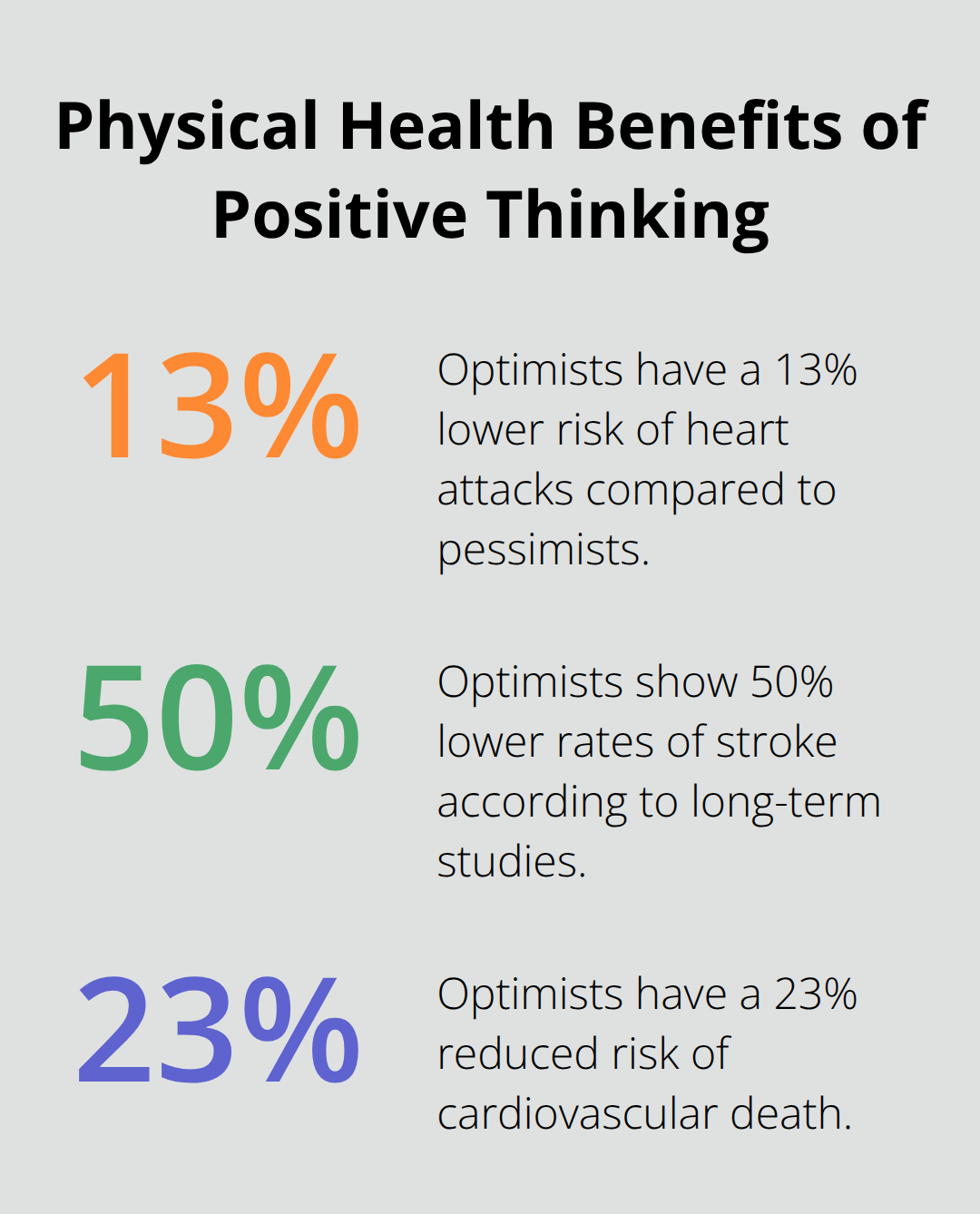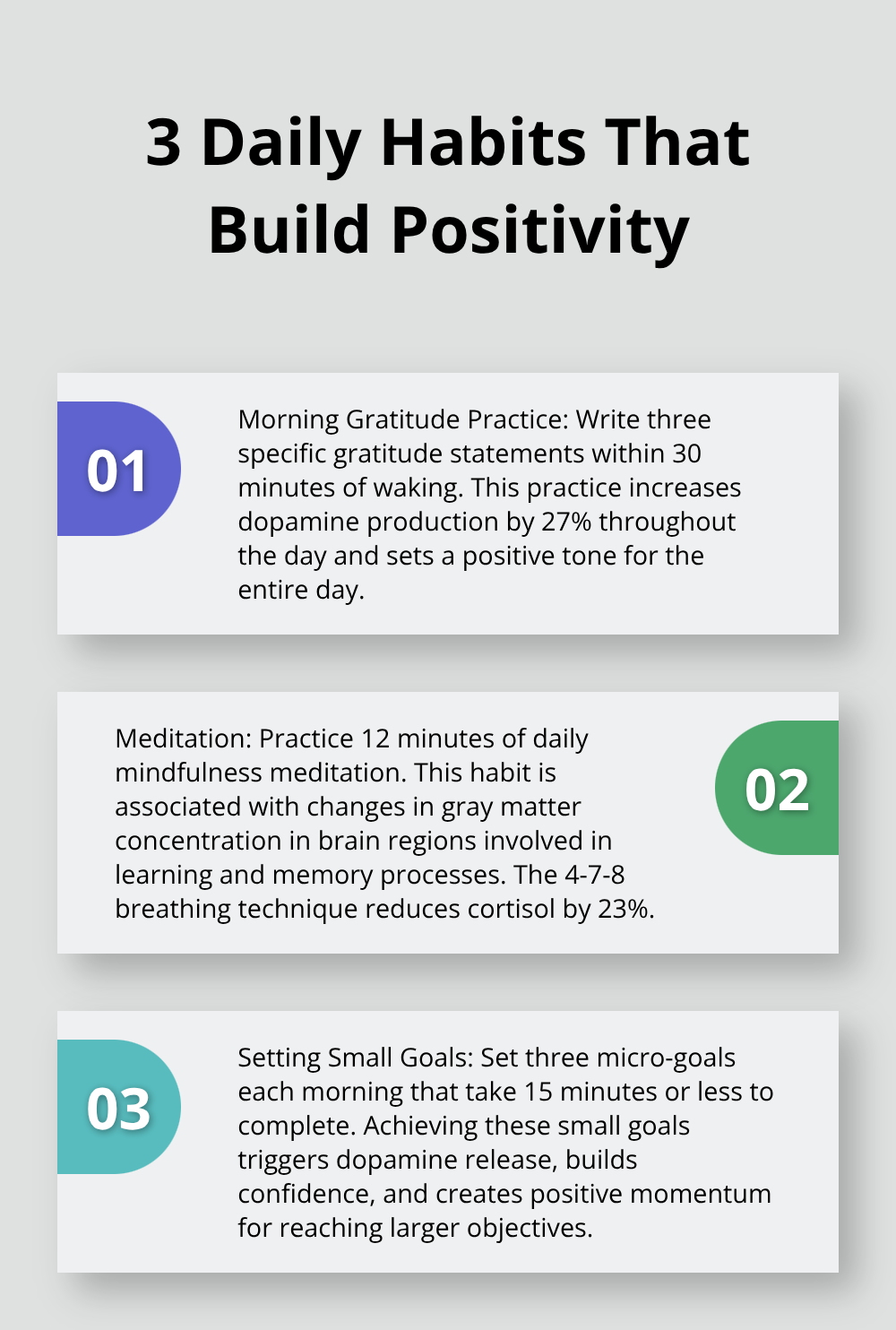Your mindset shapes everything from your daily energy levels to your long-term health outcomes. Research shows that people with a positive outlook on life live an average of 7.5 years longer than pessimists.
We at Global Positive News Network believe that optimism isn’t just a personality trait-it’s a skill you can develop. The right strategies can rewire your brain for happiness and resilience.
The Science Behind Positive Thinking
Your brain physically changes when you practice positive thoughts. Neuroplasticity research from Harvard Medical School shows that participating in an eight-week mindfulness meditation program appears to make measurable changes in brain regions associated with memory and sense of self. These pathways become stronger with repetition, which makes positive thoughts automatic rather than forced. The prefrontal cortex (responsible for decision-making) grows denser in people who practice daily gratitude exercises for just 10 minutes. Brain scans reveal that optimists have 23% more activity in the anterior cingulate cortex, the region that regulates emotions and handles stress.
Gratitude Transforms Your Mental Health
Studies from UC Berkeley found that preliminary research suggests grateful people may have better sleep, healthier hearts, and fewer aches and pains. The key is specificity – you should write “grateful for my friend Sarah who called when I felt stressed” rather than “grateful for friends.” Robert Emmons’ research at UC Davis tracked 1,000 participants for six months and found that gratitude practice increased life satisfaction scores by 25% while it reduced doctor visits by 16%. Your hippocampus, which processes memory and learning, physically grows when you maintain a gratitude practice for 60 days or longer.
Physical Health Benefits Are Measurable
Johns Hopkins research shows that people with positive outlooks have 13% lower risk of heart attacks compared to pessimists. The study followed 1,500 participants with family histories of heart disease for 25 years. Optimists also show 50% lower rates of stroke and 23% reduced risk of cardiovascular death according to Harvard School of Public Health data that spans 30 years. Your immune system produces 50% more antibodies when you maintain positive thoughts, as University of Pittsburgh researchers measured. When positive thoughts are generated, cortisol decreases and the brain produces serotonin, creating a feeling of well-being and leading to better sleep, improved digestion, and faster wound healing.

These scientific findings prove that positive thoughts create real, measurable changes in your body and mind. The next step involves turning this knowledge into daily practices that build lasting positivity habits.
Daily Habits That Build Positivity
The transition from understanding positive thinking to living it happens through three non-negotiable daily practices. Stanford neuroscientist Andrew Huberman found that people who write three specific gratitude statements within 30 minutes of waking increase dopamine production by 27% throughout the day. Your gratitude entries must include sensory details and emotions, not vague statements. Write “I felt relieved when my neighbor helped carry groceries” instead of “I’m grateful for helpful people.” UCLA research that tracked 300 participants for 12 weeks showed that people who wrote gratitude entries with specific details experienced 42% better sleep quality compared to those who wrote generic statements.

Morning Gratitude Practice Rewires Your Brain
Start each day with three specific gratitude statements that include concrete details about what happened and how it made you feel. This practice activates your brain’s reward pathways and sets a positive tone for the entire day. Research shows that people who maintain this habit for 21 consecutive days report 31% higher energy levels and improved focus throughout their morning hours.
Meditation Changes Your Brain Structure
Harvard researchers discovered that 12 minutes of daily mindfulness meditation is associated with changes in gray matter concentration in brain regions involved in learning and memory processes. The 4-7-8 breathing technique produces measurable results: inhale for 4 counts, hold for 7, exhale for 8. This pattern activates your parasympathetic nervous system and reduces cortisol by 23% according to Mayo Clinic studies. Apps like Headspace show completion rates of 78% when people meditate at the same time each morning. Your meditation session should happen before you check your phone because blue light exposure blocks the production of GABA (the neurotransmitter that promotes calm focus).
Small Goals Create Momentum Through Dopamine
MIT research proves that people who achieve small goals trigger dopamine release that motivates larger accomplishments. Set three micro-goals each morning that take 15 minutes or less to complete. Make your bed, send one text message, or walk for 10 minutes. These wins activate your brain’s reward system and build confidence for bigger challenges. Research shows that celebrating small daily achievements creates positive momentum for reaching larger objectives. Write down your completed micro-goals each evening to reinforce the positive neural pathways that drive sustained motivation.
These daily practices create the foundation for lasting change, but your environment plays an equally important role in maintaining positivity.
Surrounding Yourself with Positive Influences
Your physical and digital environment directly programs your brain for either optimism or negativity through constant exposure patterns. University of Pennsylvania research tracked participants and found that slight decreases in anxiety and fear of missing out were observed. The solution involves strategic media consumption: limit news intake to 10 minutes at 2 PM when cortisol naturally peaks, choose solutions-focused outlets that highlight progress and human achievements, and replace doom-scrolling with educational podcasts or audiobooks.

Choose Media That Elevates Your Mood
Social media algorithms amplify negative content because anger drives engagement, so actively curate your feeds by unfollowing accounts that consistently share complaints or outrage. Harvard Business Review data shows that people who follow uplifting social media accounts report better mood scores throughout the day. Replace news apps with platforms that showcase human progress, scientific breakthroughs, and community success stories. Your brain absorbs information patterns from repeated exposure, so feed it content that reinforces optimism rather than fear.
Build Your Support Network Strategically
Research shows that people with strong social connections experience significant health benefits. The key metric is quality over quantity: three close friends who actively support your goals produce better mental health outcomes than 20 casual acquaintances. Identify people who celebrate your wins rather than minimize them, and actively distance yourself from energy drains who consistently complain without seeking solutions. Join community groups centered around growth activities like hiking groups, book clubs, or volunteer organizations where positive interactions happen naturally.
Design Physical Spaces That Boost Well-Being
Environmental psychology studies prove that cluttered spaces increase cortisol production while organized environments boost focus and reduce stress hormones. Place three specific items in your most-used space that trigger positive memories: photos of happy memories, plants that require daily care, or objects that represent personal achievements. Natural light exposure for 30 minutes each morning increases serotonin production (according to Stanford research), so position your workspace near windows or invest in a 10,000-lux light therapy lamp.
Use Color Psychology to Your Advantage
Colors impact mood measurably: blue walls reduce blood pressure, green elements lower eye strain, and yellow accents increase creative thinking based on University of Texas findings. Paint your bedroom walls in soft blues or greens to promote better sleep quality. Add yellow accessories to your workspace to stimulate creative problem-solving. Research from Brigham Young University shows that people who spend time weekly in supportive social environments experience significant immune system benefits.
Final Thoughts
A positive outlook on life requires consistent daily actions rather than occasional motivation bursts. Research proves that three specific gratitude statements each morning, 12 minutes of mindfulness meditation, and micro-goals create measurable brain changes within 21 days. Your environment shapes your mindset through constant exposure patterns, so curate your media consumption and surround yourself with supportive people who celebrate your progress.
Small changes compound into transformation because your brain physically rewires through repetition. You replace negative news consumption with content that lifts your spirits, practice specific gratitude exercises, and design spaces that boost well-being to create neural pathways that make optimism automatic. The 7.5-year longevity advantage that optimists enjoy starts with today’s choices (and continues with tomorrow’s consistent actions).
Your first step involves one evidence-based practice from this guide and a three-week commitment. Whether you choose morning gratitude notes, strategic media curation, or daily meditation, consistency matters more than perfection. We at Global Positive News Network curate uplifting stories and community impact initiatives that support your path toward sustained optimism. Start tomorrow morning with three specific gratitude statements and watch how this simple practice transforms your entire day.




